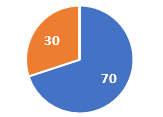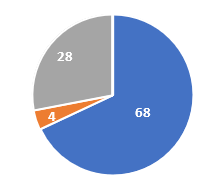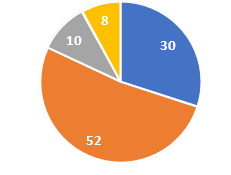Abstract
India’s National Education Policy (NEP) 2020 is a revolutionary major in the country’s higher education. However, the performance process is fraught with many problems. This research paper addresses the challenges faced by higher education institutions in India in translating the New Education Policy (2020) into practical strategies and training providers for problem-solving. While more than 7 million teachers are needed to meet the increasing number of students, the shortage of education workers is also increasing. There are not enough good teachers, we need better buildings and more technology. In an environment of stakeholder resistance and resource constraints, academic leadership and management face increasing challenges in promoting collaboration and shared ownership. Major investment in infrastructure is required, and education spending should be increased from 4.6% to 6% of GDP. In addition, lack of knowledge of regional languages and inequality in English language skills, as well as health problems and digital use, cause major problems, especially in rural and economically disadvantaged regions. It continues to explore the challenge of aligning curriculum with policy vision while addressing stakeholders and constraints. Additionally, our teaching method must comply with NEP (2020) requirements. Limited access to education and digital literacy in remote areas hinders the integration of technology and education. In addition, changing the behavior of teachers, students, and parents is important in terms of implementing new teaching methods and adapting the curriculum to changes. This paper provides administrators and educators with insight into how these issues can be addressed through research and real-life examples. Also, this paper offers policymakers, administrators, and educators insight and recommendations to address these issues. This aims to contribute to the debate on the implementation of NEP (2020) in Indian higher education by highlighting key areas that require attention and action.
Keywords: National Education Policy (NEP), Challenges, Opportunities, Teacher training, NEP implementation
Introduction
The Government of India recently issued the National Education Policy NPE 2020. It was 34 years ago when the last policy of such kind was adopted. Consequently, it will entirely reconstruct the Indian educational system and give a fresh view to it, with Indian higher education being the most affected. The National Education Policy 2020 focuses on making India a global knowledge superpower by ensuring high-quality education to all youngsters, hence, leading their creative, critical, and holistic development. This research paper will investigate what opportunities and difficulties the new NEP 2020 brings to higher education by taking into consideration the faculty’s roles, the impact on the educational ecosystem, and institutional reformation. Additionally, this study pays attention to job enlargement activities, academicians’ tasks, and the intricacy of administration in higher education. The goal of this policy is to provide students with a more diversified and integrated academic experience. By introducing multidisciplinary education, the Indian higher education system is anticipated to become more flexible and competitive globally. It also gives research and innovation a great deal of attention, which is critical to any country’s growth. However, putting these into practice will be difficult, especially in terms of allocations, talent, and standards. Hence, this study lists the problems and tries to make possible solutions.
Objectives of NEP 2020
NEP 2020 proposes the following significant changes to the higher education sector:
• To study opportunities for institutions in NEP-2020
• Founding sizable, nationally dispersed schools and institutions with a broad curriculum.
• Encouraging institutional and faculty autonomy.
• Developing the best teachers.
• Integrating skill development in higher education.
• Bridging gender and social gaps
• Promoting cultural integration through language
• Promoting Research and innovation.
• Bridging the Theory-Practice Gap.
With 1.3 billion inhabitants, India boasts a significant rural population, constituting 67% of the total. An ambitious endeavor, the “National Education Policy” 2020, seeks to revolutionize and standardize the country’s educational landscape. These reforms are designed to create a holistic and flexible educational environment that can adapt to the needs of a rapidly changing global landscape.
Materials and Methodology
In the current research, internet surveys, Government documents, Government reports, publications were employed as the primary method for data collection. Secondary sources include journal articles, news articles, books, and websites, among others. A survey on the NEP was carried out, receiving responses from 200 instructors and students from both rural and urban institutions in Kaithal (Haryana). The survey consisted of ten questions administered through a Google form, employing a selective sampling approach to gain insights into the issues and perceptions surrounding the NEP.
Results and Discussion
1. Are you aware of the National Education Policy (NEP) 2020?
Yes = 80.8 %
No = 19.2 %Pie chart showing NEP awareness

2. Do you think the NEP will bring positive changes to the education system?
Yes = 40 %
No = 10 %
Not sure = 50 %
Pie chart showing NEP awareness

3. Do you believe that NEP 2020 will help in reducing rote learning?
Yes = 72 %
No = 9 %
Not sure = 19 %
Pie chart showing NEP awareness

4.Are you satisfied with the proposed changes to the school curriculum under NEP 2020?
Yes = 73 %
No = 9 %
Not sure = 19 %
Pie chart showing NEP awareness

5.Do you think that the NEP will bridge the gap between urban and rural education?
Yes = 58 %
No = 18 %
Not sure = 24 %
Pie chart showing NEP awareness

6.Do you think technology plays an important role in implementing NEP 2020 effectively?
Yes = 92 %
No = 2 %
Not sure = 6 %
Pie chart showing NEP awareness

7.What are the major problems you think in implementing the NEP 2020?
Lack of infrastructure = 30 %
Lack of teacher training = 2 %
curriculum adaptation = 10 %
others = 8 %
Pie chart showing NEP awareness

8.Do you think NEP 2020 effectively addresses the need for infrastructure development in education?
Yes = 68 %
No = 4 %
Not sure = 28 %
Pie chart showing NEP awareness

9.Have you received any training or guidance on implementing the NEP 2020?
Yes = 70 %
No = 30 %
Pie chart showing NEP awareness

10. Do you think establishing a National Research Foundation and by adopting new Innovative Teaching Methods will improve the education level in India?
Yes = 88 %
No = 12 %
Pie chart showing NEP awareness

Most people think that the biggest problem in implementing NEP 2020 is money and lack of well-trained teachers as well as infrastructure. Almost all people agree that technology plays a vital role in improving the education system. We should adopt new teaching methods and also improve our infrastructure. From time to time, we should spread awareness about NEP 2020 by conducting seminars or quizzes because as seen in the survey report above, many of them have no awareness about NEP 2020. There are many other problems in implementing NEP 2020.
Obstacles to NEP 2020 implementation
Establishing a new institution every week is a difficult task. More than a thousand colleges and universities have opened their doors in India in recent years. However, to achieve the policy’s target of doubling the gross enrollment ratio in higher education by 2035, one new institution would need to be established every 15 years. A new institution would be established each week, and that would be an enormous task.[4]
Practices for Job Enlargement: Job enlargement in higher education implies that faculty members will be in charge of more than just teaching; it will involve managing responsibilities as well. In the Western system, this type of job is known as a manageracademic. However, this type of job would not fit India and would pose problems unique to Indian circumstances. Indian professors are expected to participate in institution administration, in addition to their core teaching and research work, as is the case in most other countries. However, this is not well established and is much more onerous compared to other nations.[1]
Professional Duties of Academicians: Academic and administrative responsibilities make up the two primary categories of professional responsibilities for academicians in India. Administrative responsibilities include extracurricular activities, record-keeping supervision, assessment report maintenance, and participation in various university committees. Academic responsibilities include creating lectures, carrying out research, supervising research fellows, and taking part in university exams..[5] Each of the above-stated professional responsibilities is discussed briefly; this dual-duty framework necessitates a robust network of assistance to guarantee that faculty members can efficiently deal with these increased duties while also maintaining the quality of their teaching and research work. However, the present system often does not offer the level of assistance required, which may increase faculty members’ overall job responsibilities and burden, as well as diminish their teaching quality or research and job satisfaction. To address these weaknesses, a robust network of support is required to guarantee that these dual roles can function without overburdening faculty members. Such support should be based on promoting a friendly and supportive work civilization that recognizes the contributions of professors functioning in academic and administrative capacities.
Technology: To compensate for the lack of physical infrastructure, modern teaching methods like digital classrooms, remote expert-led instruction, and AR/VR tools can be implemented. A digital infrastructure of similar size will also be necessary to ensure standardized assessments and career guidance even in remote areas [6]
Administrative Challenges: Several administrative barriers to the implementation of NEP 2020 involve resource difficulties, maintaining quality standards, and human resources shortages in higher education. One of the major problems is the lack of well-trained education managers. This dilemma has resulted in educators being encouraged to undertake tasks for which they are not prepared as administrators and that distract them from their main objectives: teaching and learning [7] Furthermore, higher education institutions must undergo a “cultural change” to reward and recognize academics and administrators’ achievements and contributions.
Quality Assurance and Accreditation: Accreditation is highlighted in higher education by the Rashtriya Uchchatar Shiksha Abhiyan (RUSA) program. It encourages research and innovation and expects all universities to follow the NAAC process. The most challenging element of implementing these standards is extensive preparation and an unbiased, welltrained state-level decision-making process [3] [7]. A comprehensive and coordinated solution to the complicated and multi-faceted challenge of quality standards in higher education will need to be devised. This entails assigning strong quality control systems, providing teachers, and staff necessary resources and support, and fostering a culture of change and innovation. In addition, the need to use quality assurance procedures that are open, impartial, and inclusive, as well as considerate of the different requirements and circumstances in which institutions work, is essential. By taking these steps, higher education institutions will be able to ensure that they can give a high-quality education and support to all students.
Faculty Development and Leadership: NEP 2020 places a strong emphasis on the necessity of effective leadership and ongoing professional development in higher education, with faculty development serving as a pillar..[8] The policy emphasizes the significance of appointments made based on merit and career advancement determined by teaching, research, and service. The objective of this method is to cultivate an environment of quality and innovation in higher education establishments.
Challenges in Faculty Development: Faculty development is critical, as several challenges in India are counter-productive to faculty growth, including limited prospects for training, inadequate academic leadership, and an absence of mentoring. A significant proportion of academicians, as indicated by a study, indicated that there is a considerable leadership capability gap, impacting the overall quality of higher education.
Challenges in Research and Innovation: Policy NEP 2020 also aims to create a strong culture and ecosystem for quality research in Indian HEIs through the development of a National Research Foundation (NRF). This foundation would fund projects validated by peer review and help in the formation of world-class research systems and infrastructure.[8] The Policy envisions that the quantity and quality of research in Indian universities, which is not comparable to many global leaders, would increase. However, funding is not the sole means of creating an ecosystem for quality research. It takes sustained efforts to help teachers and students become researchers, to create opportunities for collaboration, and to ensure that the findings are disseminated and applied.
Strategic Initiatives for Implementation: Some strategic measures are suggested in order to deal with the difficulties and take advantage of the potential that NEP 2020 presents:
Establishing a National Research Foundation: The creation of the National Research Foundation (NRF) to enhance universities and colleges’ research efforts and allow funds to be granted for outstanding peer-reviewed research in all fields.[3]
Governance Reforms: Independent boards with institutional and academic autonomy to set high standards for governance to be formed.[4]
Innovative Teaching Methods: Emphasizing participatory and innovative teaching-learning methodologies to enhance the learning experience.
Infrastructure Development: Improving infrastructure and learning materials to ensure accessibility and inclusivity for all learners.[3]
Funding education: The emphasis is to invest up to 6 percent of GDP in the education sector. At present it is 4.43 percent of GDP.[9]
Creating a large number of well-trained teachers: The new curriculum changes in education cannot be properly implemented in schools unless a large pool of qualified educators is created. Although the restructuring of the curriculum is a good step, it calls for teachers who possess the pedagogical knowledge and abilities needed.[10] Also, most of the recommended changes will need major psychological shifts on the part of parents and teachers, making it difficult to make the required personnel adjustments. For example, it will be impossible to transform the preparation system in higher education so that teachers adopt interdisciplinary education and are all exceptional in their respective areas. Although it is feasible, this will necessitate a cultural alteration that will most likely require the whole higher education system to change over the next 15 to 20 years.
Conclusion
The implementation of NEP 2020 in higher education presents both significant challenges and unprecedented opportunities. By focusing on job enlargement practices, addressing administrative challenges, and fostering faculty development, India can achieve the transformative goals set forth by NEP 2020. The success of this policy will depend on the collective efforts of all stakeholders, including government bodies, educational institutions, and faculty members.
References:
[1] R. Gandhi Arora associate professor and R. Gandhi Arora. (2020) [Online]. “New education policy 2020: Job enlargement practices in higher education institutions in India,” ~ 12 ~ International Journal of Research in Human Resource Management, 4(2) (pp. 12–16). http://www.humanresourcejournal.com
[2] Dr Sachdeva, D. V., & Dr Latesh, D. (June 2023). NEP 2020: Emphasizing experiential learning and inquiry-based approaches in higher education. International Journal of Applied Research, 9(6), 179–184. https://doi.org/10.22271/allresearch.2023.v9.i6c.10938
[3] Jatav, V. K., Kaur Bansal, S., Bairwa, K., & Saini, K. “National Education Policy 2020: Challenges and Opportunities for Students and Institutions in Higher Education” [Online]. http://www.ijfmr.com
[4] Kumre, S. P. “NEP 2020-Opportunities and Challenges” [Online]. http://www.ijfmr.com
[5] Santra, R., & Basu, S. “National Education Policy 2020: Opportunities and Challenges for India’s Higher Education” [Online]. http://www.ijfmr.com
[6] Nandi, A. “National Education Policy 2020-Challenges and Opportunities on the Educational System” [Online]. http://www.ijfmr.com
[7] Lakshmi, V. V., & Ugandhar, T. “Problems, Obstacles, and Suggestions for Improving the Quality of Higher Education Institutions in NEP” [Online]. http://www.ijfmr.com
[8] Chowdhury, A. R., & Hanumanthu, P. (May 2023). Analysing India’s national education policy from the angle of research, IP, innovation, and entrepreneurship. Journal of Intellectual Property Rights, 28(3), 211–215. https://doi.org/10.56042/jipr.v28i3.1616
[9] Dr Verma, D. H., & Kumar, A. (August 2021). New education policy 2020 of India: A theoretical analysis. International Journal of Business and Management Research, 9(3), 302–306. https://doi.org/10.37391/IJBMR.090308
[10] Dr Reddy, M. V. B., Dr Rao, P. B., & Keerthi, G. (2023). ‘ISSUES AND EMERGING CHALLENGES FOR NEP 2020,’ interantional journal of scientific research in engineering and manageme nt, 07(05, May). https://doi.org/10.55041/ijsrem20290
